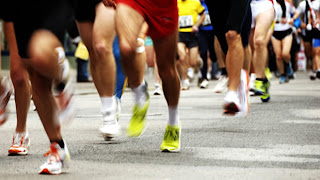It's ubiquitous in endurance sports - the pre-race carbo-load. It comes in the form of stuffing every pore in your body with pasta and bread. God help you if you don't eat enough, for you will collapse on the course due to glycogen depletion, and be shunned by your training buddies and all passersby.
Sounds familiar? If you are an endurance athlete, or know one, there is no doubt this is something you have experienced before. We follow this unwritten nutritional law without question, but does carbo-loading actually work? The short answer is - it depends. Early studies examining the effects of carbo-loading on delaying fatigue during endurance performance were positive - those who loaded performed at a higher level for longer than their non-loaded controls. These results seem reasonable, but as with any research study, one needs to look a little deeper than the results.
The problem with these studies was that they did not allow for nutrition during the bout of exercise. They simply measured how long the subject lasted until fatigue set in - not what you would consider a real life scenario. Do you typically feed once and race until you can go no farther? No - you get some calories before the start, and then periodically consume small amounts throughout the race. In fact, when you adjust the experiment to allow for periodic consumption of calories, the benefit of loading is negated. Secondly, most of these studies were performed using a stationary bike - a non-weight-bearing exercise. For a runner, the additional weight gain from loading, which can exceed 5 pounds, is actually detrimental to performance.
When we control for the above problems, there is no benefit from carbo-loading in events of 2 hours duration or less. So for most half marathon and shorter distance triathlons, stick to your normal diet and race day nutrition. For events of longer duration the carbo-load is one option, but may not be the most efficient.
Our bodies are filled with a virtually limitless supply of fat, making it a great fuel option to achieve maximum economy. So how do you increase your body's reliance on fat during endurance sports? Let's focus on the two most important strategies: endurance training and fat-loading.
Prior to beginning endurance training your body will utilize approximately equal parts glycogen and fat for energy during exercise. Following a season of training, the percentage will be closer to 60% fat, 40% glycogen. This means less reliance on blood glucose and muscle glycogen for energy, and ultimately delayed fatigue. The reasons for this are quite complex, but if you are reading this article you are probably either currently or are close to beginning your training cycle for next year, and will see the benefits of this change on your performance.
The second strategy for improved performance I want to explore is fat-loading. The principle here is that we can teach our bodies to use fat by feeding them fat, with the results being you will rely less on carbohydrates and improve performance. Again, the mechanisms are complex, but in a nutshell your body will adapt to the sources of fuel available - fat being no exception. The introduction of more fat into your diet will trigger a change in enzyme production and metabolic pathways, resulting in more efficient utilization of fat. In theory this sounds reasonable, but does it work in a real-world race setting? As with carbo-loading, it depends. Research has found that during bouts of sub-maximal exercise, time to fatigue was delayed utilizing a high-fat load. However, a second study found that no benefit was seen during a time trial, which more closely represents the stresses of a race.
Great - now what to do? This article should bring home a very important point regarding nutrition for endurance athletes. In an era of extremes in both training and nutrition, it's good to take a step back and realize that the best approach is usually to follow the middle road instead of the fad. While some athletes are great carbohydrate utilizers and some great fat utilizers, the reality is that the vast majority of us utilize a fairly even mix and do best with a normal balanced diet with perhaps slightly more fat than a non-endurance athlete, and a slightly higher intake of carbohydrates the days leading up to your longer races. The takeaway is to not overdo it on either extreme. High carbohydrate intake may leave you several pounds heavier on that 50 mile run, while high fat intake offers its own set of problems. As in life, there are no quick fixes here and operating on the extremes will almost certainly do you more harm than good. Practice moderation, train appropriately, and you will be just fine.
Dr. Adam Meisenhelder is a Sports Chiropractor in Beaverton, Oregon specializing in working with injured runners and endurance athletes. Learn more at http://www.mybeavertonchiropractor.com
Article Source: http://EzineArticles.com/?expert=Adam_Meisenhelder




